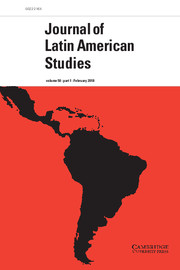- Accessibility Options:
- Skip to Content
- Skip to Search
- Skip to footer
- Office of Disability Services
- Request Assistance
- 305-284-2374
- Display:
- Default
- High Contrast
- Apply
- About UM
- Give to UM
-
Schools
- School of Architecture
- College of Arts and Sciences
- Miami Herbert Business School
- School of Communication
- School of Education and Human Development
- College of Engineering
- School of Law
- Rosenstiel School of Marine, Atmospheric, and Earth Science
- Miller School of Medicine
- Frost School of Music
- School of Nursing and Health Studies
- The Graduate School
- Division of Continuing and International Education
- Alumni
- The Mexican Heartland: How Communities Shaped Capitalism, a Nation, and World History, 1500-2000.
- Hablamos la misma lengua. Historia política del español en América, desde la Conquista a las Independencias
- “The Tragedy of the Venezuelan Opposition: Why It’s Been Unable to Effectively Challenge Maduro.”
- “Las poéticas del sinsentido en la literatura argentina contemporánea: reflexiones acerca de su relación con la ironía, el kitsch y el camp.”
- “Developing a cooperative multicenter study in Latin America: Lessons learned from the Latin American Study of Nutrition and Health Project.”
- “U.S. Free Trade Agreements (FTAs) and Enforcement of Labor Law in Latin America.”
- “Becoming the ‘Baddest’: Masculine Trajectories of Gang Violence in Medellín.”
- “Cultural stressors, identity development, and substance use attitudes among Hispanic immigrant adolescents.”
- “The Latino/a audience unbound: Intra-ethnic social hierarchies and Spanish-language television news.”
- “The Reactive Left: Gender Equality and the Latin American Pink Tide.”
RELATED LINKS
- The Mexican Heartland: How Communities Shaped Capitalism, a Nation, and World History, 1500-2000.
- Hablamos la misma lengua. Historia política del español en América, desde la Conquista a las Independencias
- “The Tragedy of the Venezuelan Opposition: Why It’s Been Unable to Effectively Challenge Maduro.”
- “Las poéticas del sinsentido en la literatura argentina contemporánea: reflexiones acerca de su relación con la ironía, el kitsch y el camp.”
- “Developing a cooperative multicenter study in Latin America: Lessons learned from the Latin American Study of Nutrition and Health Project.”
- “U.S. Free Trade Agreements (FTAs) and Enforcement of Labor Law in Latin America.”
- “Becoming the ‘Baddest’: Masculine Trajectories of Gang Violence in Medellín.”
- “Cultural stressors, identity development, and substance use attitudes among Hispanic immigrant adolescents.”
- “The Latino/a audience unbound: Intra-ethnic social hierarchies and Spanish-language television news.”
- “The Reactive Left: Gender Equality and the Latin American Pink Tide.”
RELATED LINKS





 Abstract: Drawing upon 40 life-history interviews with gang members in Medellín, Colombia, this paper argues that many young men join gangs to emulate and reproduce ‘successful’ local male identities. The accumulation by the gang of ‘masculine capital,’ the material and symbolic signifiers of manhood, and the accompanying stylistic and timely displays of this capital, means that youths often perceive gangs to be spaces of male success. This drives the social reproduction of gangs. Once in the gang, the youths become increasingly ‘bad,’ using violence to defend the gang’s interests in exchange for masculine capital. Gang leaders, colloquially known as duros or ‘hard men,’ tend to be the más malos, the ‘baddest.’ The ‘ganging process’ should not be understood in terms of aberrant youth behavior; rather there is practical logic to joining the gang as a site of identity formation for aspirational young men who are coming of age when conditions of structural exclusion conspire against them.
Abstract: Drawing upon 40 life-history interviews with gang members in Medellín, Colombia, this paper argues that many young men join gangs to emulate and reproduce ‘successful’ local male identities. The accumulation by the gang of ‘masculine capital,’ the material and symbolic signifiers of manhood, and the accompanying stylistic and timely displays of this capital, means that youths often perceive gangs to be spaces of male success. This drives the social reproduction of gangs. Once in the gang, the youths become increasingly ‘bad,’ using violence to defend the gang’s interests in exchange for masculine capital. Gang leaders, colloquially known as duros or ‘hard men,’ tend to be the más malos, the ‘baddest.’ The ‘ganging process’ should not be understood in terms of aberrant youth behavior; rather there is practical logic to joining the gang as a site of identity formation for aspirational young men who are coming of age when conditions of structural exclusion conspire against them.